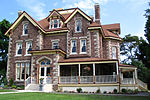The Welland Canal is a ship canal in Ontario, Canada, connecting Lake Ontario and Lake Erie. It forms a key section of the St. Lawrence Seaway and Great Lakes Waterway. Traversing the Niagara Peninsula from Port Weller in St. Catharines to Port Colborne, it enables ships to ascend and descend the Niagara Escarpment and bypass Niagara Falls. It is the fourth canal connecting these waterways; three smaller predecessors also bore the same name.
The Welland Canal passes about 3,000 ships which transport about 40 million tonnes (88 billion pounds) of cargo a year. It was a major factor in the growth of the city of Toronto, Ontario. The original canal and its successors allowed goods from Great Lakes ports such as Cleveland, Detroit, Milwaukee, and Chicago, as well as other heavily industrialized areas of the United States and Ontario, to be shipped to the Port of Montreal or to Quebec City, where they were usually reloaded onto ocean-going vessels for international shipping.
The Welland Canal in use today is the Fourth Welland Canal. The First Welland Canal was excavated 7.3 metres (24 ft) wide and 2.4 metres (8 ft) deep from 1824–1829 with forty wooden locks and commenced operation on November 30, 1829. The Second Welland Canal began excavation in 1841 and was wider at 11 metres (36 ft) and deeper at 2.7 metres (9 ft) with larger locks made of stone to replace the wooden locks used in the first canal. It was wider and deeper than the first to provide access for larger ships up to 46 metres (150 ft) long. The Second Welland Canal was completed in 1845 and remained in operation for nearly a century before closing permanently in 1935. The Third Welland Canal was designed to follow a straighter and thus shorter route than the first two and began construction in 1872 through 1887. It was 30 metres (100 ft) wide and 4.3 metres (14 ft) deep, with 26 masonry locks lined with wood to protect ships rubbing against the sides or bottom. The Third Canal locks were again larger being 14 metres (45 ft) wide and 82 metres (270 ft) long. The canal permitted access to larger ships with the Third Canal operating from 1887 until 1935 along with the still operating Second Welland Canal. The Fourth Welland Canal began construction in 1913 and was completed in 1932 with a delay due to World War I consuming vital manpower and materials. The Fourth Canal was once again an enlarged design to accommodate the increased size of ships with the main channel now 110 metres (350 ft) wide and 9.1 metres (30 ft) deep to permit two large ships to pass going in opposite directions. The current locks are 24 metres (80 ft) wide and 233 metres (766 ft) long. Three years after the Fourth Canal began operating in 1932 the government of Canada closed the Second and Third canals which required costly upkeep as they were deemed redundant. The Fourth Canal is equipped with just eight locks compared to the forty locks needed by the First Welland Canal. In comparison the Panama Canal opened in 1914 with locks 34 metres (110 ft) wide and 320 metres (1,050 ft) long.The Welland Canal eclipsed other, narrower canals in the region, such as the Trent-Severn Waterway and, significantly, the Erie Canal (which linked the Atlantic and Lake Erie via New York City and Buffalo, New York) by providing a shorter, more direct connection to Lake Erie.The southern, Lake Erie terminus of the canal is 99.5 metres (326 feet) higher than the northern terminus on Lake Ontario. The canal includes eight 24.4-metre-wide (80 ft) ship locks. Seven of the locks (Locks 1–7, the 'Lift' locks) are 233.5 m (766 ft) long and raise (or lower) passing ships by between 13 and 15 m (43 and 49 ft) each. The southernmost lock, (Lock 8 – the 'Guard' or 'Control' lock) is 349.9 m (1,148 ft) in length. The Garden City Skyway passes over the canal, restricting the maximum height of the masts of the ships allowed on this canal to 35.5 m (116 ft).
All other highway or railroad crossings of the Welland Canal are either movable bridges (of the vertical lift or bascule bridge types) or tunnels. The maximum permissible length of a ship in this canal is 225.5 metres (740 feet). It takes ships an average of about eleven hours to traverse the entire length of the Welland Canal.








